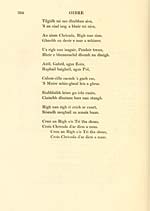Ossian Collection > Carmina gadelica > Volume 1
(367)
Download files
Complete book:
Individual page:
Thumbnail gallery: Grid view | List view

LABOUR 323
FISHING BLESSING
The people of Uist say that the haddock was the fish in whose mouth Peter found
the tribute-money, and that the two black spots are the marks left by Peter's
fingers when he held the fish to extract the money from its mouth. The crew of
young men who get most haddocks on Christmas Day are looked upon during the
year as the real followers of the king of fishers. There is, therefore, considerable
emulation among the different crews.
The haddock is called ' iasg Pheadail,' Peter's fish, and 'iasg Pheadair runaich,'
the fish of loving Peter; and a family of birds ' peadaireach/ 'peitirich' — Peter-like,
petrels, because in their flight they seem to be walking on the sea.
The tradition as to rowing 707 strokes is curious and interesting. The only
other similar tradition which I know is of the wars between the Fomorians and
the Milesians in Ireland. Both were invaders : — the Milesians earlier, the
Fomorians later. When the Fomorians landed in Ireland the Milesians were already
established, and the result was a long-continued war, till both sides were exhausted
and tired of the strife. During a temporary truce it was agreed that the
Fomorians should retire to the sea and row straight out 707 strokes from land, and
if they succeeded in landing again they were to be allowed to remain and enjoy
their hard-won honours. Whether for good or for ill to Ireland, the Fomorians
effected a landing a second time, and settled in the south and west of the island.
The Irish were Pagan at the time, and the tradition of the 707 strokes being
imposed by Christ on Peter must have been inserted in the Fomorian tradition after
Ireland became Christian.
The day of light has come upon us,
Christ is born of the Virgin.
In His name I sprinkle the water
Upon every thing within my court.
Thou King of deeds and powers above,
Thy fishing blessing pour down on us.
I will sit me down with an oar in my grasp,
I will row me seven hundred and seven [strokes].
FISHING BLESSING
The people of Uist say that the haddock was the fish in whose mouth Peter found
the tribute-money, and that the two black spots are the marks left by Peter's
fingers when he held the fish to extract the money from its mouth. The crew of
young men who get most haddocks on Christmas Day are looked upon during the
year as the real followers of the king of fishers. There is, therefore, considerable
emulation among the different crews.
The haddock is called ' iasg Pheadail,' Peter's fish, and 'iasg Pheadair runaich,'
the fish of loving Peter; and a family of birds ' peadaireach/ 'peitirich' — Peter-like,
petrels, because in their flight they seem to be walking on the sea.
The tradition as to rowing 707 strokes is curious and interesting. The only
other similar tradition which I know is of the wars between the Fomorians and
the Milesians in Ireland. Both were invaders : — the Milesians earlier, the
Fomorians later. When the Fomorians landed in Ireland the Milesians were already
established, and the result was a long-continued war, till both sides were exhausted
and tired of the strife. During a temporary truce it was agreed that the
Fomorians should retire to the sea and row straight out 707 strokes from land, and
if they succeeded in landing again they were to be allowed to remain and enjoy
their hard-won honours. Whether for good or for ill to Ireland, the Fomorians
effected a landing a second time, and settled in the south and west of the island.
The Irish were Pagan at the time, and the tradition of the 707 strokes being
imposed by Christ on Peter must have been inserted in the Fomorian tradition after
Ireland became Christian.
The day of light has come upon us,
Christ is born of the Virgin.
In His name I sprinkle the water
Upon every thing within my court.
Thou King of deeds and powers above,
Thy fishing blessing pour down on us.
I will sit me down with an oar in my grasp,
I will row me seven hundred and seven [strokes].
Set display mode to: Large image | Transcription
Images and transcriptions on this page, including medium image downloads, may be used under the Creative Commons Attribution 4.0 International Licence unless otherwise stated. ![]()
| Early Gaelic Book Collections > Ossian Collection > Carmina gadelica > Volume 1 > (367) |
|---|
| Permanent URL | https://digital.nls.uk/78421946 |
|---|
| Description | Volume I: Achaine (invocations) Aimsire (seasons) Oibre (labour). |
|---|---|
| Shelfmark | Oss.292 |
| Additional NLS resources: | |
| Attribution and copyright: |
|
| Description | Selected books from the Ossian Collection of 327 volumes, originally assembled by J. Norman Methven of Perth. Different editions and translations of James MacPherson's epic poem 'Ossian', some with a map of the 'Kingdom of Connor'. Also secondary material relating to Ossianic poetry and the Ossian controversy. |
|---|
| Description | Selected items from five 'Special and Named Printed Collections'. Includes books in Gaelic and other Celtic languages, works about the Gaels, their languages, literature, culture and history. |
|---|

